Last Updated on October 20, 2022 by The Tutor
How to Light a Kitchen
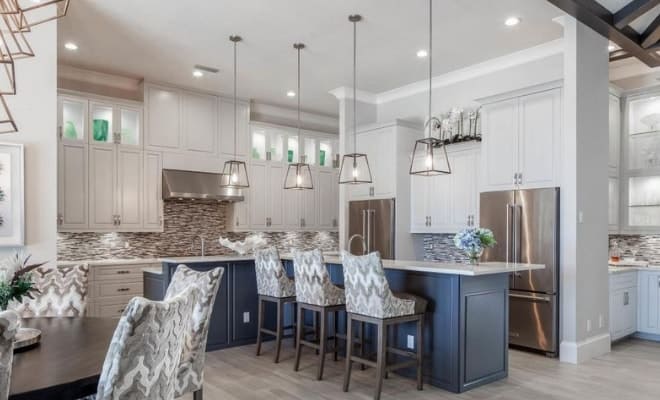
The kitchen is the focal point of the home. It is where family and friends get together and spend most of their waking hours. Kitchens are often the key to selling your home and can also add value if done right. It is for these reasons why learning how to light a kitchen effectively is critically important.
There are so many options when it comes to kitchen lighting. This article is not about which light fixtures in particular to choose because that is really a personal decorative choice for you. I will take you through the important elements of how to light a kitchen and from there you can decide which method is best for your kitchen.
The Key Elements to Light a Kitchen Effectively 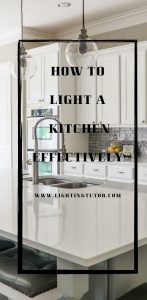
When it comes to lighting a kitchen, you need to balance your lighting to fit the various needs in all corners of your kitchen. You will likely have different lighting needs over your kitchen island vs your kitchen table. Therefore, it is critical to consider the following key elements:
- Total Coverage
- Ambient Lighting
- Task Lighting
- Accent Lighting
- Layering your Kitchen Lighting
- Adding Dimmers
Total Coverage – The most important thing is to cover the entire room with some type of lighting with no dark spaces at all. It is okay for a family room to have a darker area of the room but not a kitchen. This is not to say that the entire kitchen will be lit up like a baseball stadium.
What you are trying to avoid are areas of the kitchen that are extremely dark. Do not skimp on the number of recessed lights. Choose more fixtures and use bulbs with lower lumens if needed.
Ambient Lighting – Ambient lighting is what typically provides most of the total coverage in your kitchen. It is usually the recessed lighting that is evenly or strategically spaced and provides the base lighting for your entire room. Kitchens with just one or two lights near the middle are not providing adequate light. Then, when you are standing at the counter you are likely blocking the light needed to see on the counter.
Although the ambient lighting is bright enough to see, it does not provide the bright, focused task lighting needed in certain areas of the kitchen.
Task Lighting – Task lighting provides light that is bright enough to manage the various tasks in your kitchen such as chopping vegetables or cooking over our stove. The areas where task lighting is most important is your kitchen island, over your stove and also at times on the counters beneath your cabinets. These are the areas where the work gets done. One may also add the kitchen table to the task lighting list.
Accent Lighting – Accent lighting is where you can get creative and let your imagination take over. This lighting is for visual effect only and does not serve to provide either ambient or task lighting. Accent lighting will add that final touch to your kitchen making it look spectacular.
Some examples of accent lighting are kick plate lighting below your lower cabinets, lighting inside of glass front cabinet doors, a lit tray ceiling and even lighting that turns on inside of your drawers.
Read our article on kitchen accent lighting. 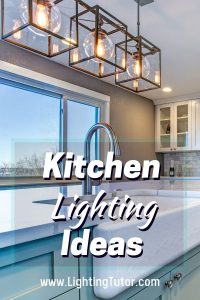
Layering your Kitchen Lighting – Consider layering all of the lighting types referenced above to achieve the maximum effect and benefit from your kitchen lighting.
Layering with recessed lighting, pendant lights, under cabinet lights and then some additional accent lighting provides the atmosphere that you often see in the most expensive homes. The good news is you do not have to spend too much on light fixtures to have the same effect in your kitchen.
Remember to pair the various lighting fixtures and the kelvin color temperatures to either be consistent across the entire kitchen or be very close to one another in temperature. Example, if you have 3500k recessed lights, then your pendants should be within 500k of your ceiling lights. You can have lights that are brighter (more lumens) but the temperatures should all be consistent.
Dimmer Switches to Tie Your Kitchen Lighting Together
The first thing to plan when designing your kitchen lighting is to have all of the various fixtures on different switches. Recessed lighting on one switch, pendants over the island on another, and the under cabinet lights should have their own switch too. Even the lighting over your kitchen table should be on its own switch. If that is also recessed lighting, then have the lights over your table on an independent switch.
Next, these should all be dimmer switches. Dimmers allow you to create an ambiance for every occasion. This is true for recessed lights, pendants and under cabinet lights. There will be instances where you need something different than full brightness from your lights.
In our home, we always have the kitchen lights dimmed down in the evening. It creates such a cozy atmosphere. Who wants to have a romantic dinner with recessed lights beaming down like a hospital room? You will want to dim them way down and them maybe light a candle on the table.
I suggest reading how to choose a dimmer switch before making your final lighting decisions. Remember to choose both fixtures and bulbs that are compatible with dimmers.
Recessed Lighting in the Kitchen
The majority if not all ambient light in the kitchen will come from recessed lighting. It is the most efficient and modern way to accomplish this today. Although you can customize a bit with various types of recessed lighting trim, this type of lighting primarily serves the purpose of adding ambient light and is typically not for decorative purposes.
Unlike other rooms, recessed lighting may not always be installed uniformly throughout the kitchen. Instead, there may be more of a strategic placement of the recessed lighting cans in the kitchen. When designing your kitchen lighting layout, you will start with the placement of your pendants if you plan to use those. Then, you can add recessed lighting throughout the rest of the kitchen to fill in where needed.
To help plan your recessed lighting, read how to layout recessed lighting before making any final decisions. This will help to give you some ideas on how to light a kitchen with recessed lighting. The photo below is just an example of what I am referring to.
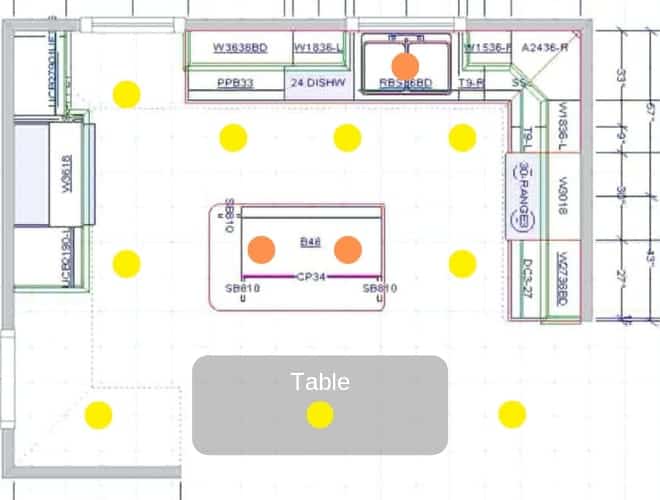
How to light a kitchen with recessed lighting
Recessed lights can be added in multiple locations with various switches controlling them. For example, you may have one switch controlling one recessed light over your sink (if that is how you decide to light your sink), one for the lights over your kitchen table, one for lights that may be over your island, etc.
If for some reason you are unable to add recessed lighting into your kitchen ceiling, then you can go with flush mount fixtures. These are not the most optimal when it comes to creating ambient light for your kitchen. If you have to choose this method, then add multiple smaller flush mounted lighting fixtures in your kitchen rather than one large one in the center of the room. This will provide more of the coverage that you need.
When it comes time to shopping for recessed lighting, take a look at our recommended recessed lighting fixtures before you make your purchase. These have been fully vetted and you can use and install with confidence. The cost associated with recessed lighting is minimal and should not impact your kitchen remodel budget.
Pendant Lighting for the Kitchen
Pendant lights are extremely popular right now and there may be more pendant lighting options than any other type of lighting. You will see hundreds of thousands of photos of pendant lighting ideas on Pinterest and other places.
Pendant lights are likely where you will be able to add some design, flair and character to the lighting in your kitchen. Although pendant lights serve a function by providing some task lighting over important work surfaces, they also allow room for your creativity. This is where I would spend a little more money in selecting the perfect pendant lights.
Pendant lights allow you to deviate a bit from the color scheme in your kitchen. It is okay to add something that has wild colors or is an interesting shape. The great part about pendant lights is they are never permanent. These are easy to replace at any time and can be done by the average homeowner who has the basic ability to work with electricity.
Pendants are typically used over the kitchen island and sometimes over the sink. At times, they are also used over the kitchen table. These are all great areas to accessorize with unique and conversation starting pendant lights.
Under Cabinet Lights
Under cabinet lighting will bring your kitchen to life if done right and should be considered for all kitchen remodels. Adding under cabinet lighting is also a great way to upgrade an older kitchen that you would like to give a small facelift to. The added element they bring to the room is absolutely amazing
They are available in hard wired versions as well as battery operated. They have dimmers and can also come with multiple kelvin color settings. We put together a list of recommended under cabinet lighting options which have been tested here.
The goal is to provide ample lighting across your counter surfaces while also highlighting your backsplash. However, there is an art to doing it in a way that delivers both task lighting as well as ambiance at the same time.
We have talked about choosing the right lighting for your granite countertops in the past. It comes down to selecting the right kelvin color temperature to match not only the other lights in the room but also to bring out the beauty of your counters.
Your options for under cabinet lighting will be:
-
- Hard wired LED linear fixtures
- Wireless LED light bars
- Puck lights
- Tape lights or strip lights
Read all about the various under cabinet lighting options to help you with your decision. If you are a DIY person, then you may want to read about how to install under cabinet lighting. This is a project that you can absolutely tackle yourself if you are comfortable working with electricity.
Kitchen Island Lighting
When we say that the kitchen is the gathering place in the home, the kitchen island is the place where most people gather in the kitchen. When we have guests over we often stand around the island with drinks in our hands, having some food there and just talking for hours. The lighting over your kitchen island will be critical in making that space work.
The size of your kitchen island will truly determine how many light fixtures you will need for coverage. I recommend reading how to light a kitchen island to get our full explanation and plan. The goal here is to provide task lighting while you are working at the island, but then transition that lighting to add ambiance when the island is being used for more social settings.
There are ways you can light your kitchen island:
Recessed Lighting – You can add recessed lights above your island and they can be the only lighting provided for your island. If you choose this route, I recommend placing recessed lights that are specific to the island only. This means they may be smaller in size or have more lumens. They also should be on their own switch and with a dimmer.
If you do not like pendants, this could be the way to go. This does however take the decorative benefits out of the equation.
Pendant Lighting – Pendant lights are the most popular way to provide lighting over your kitchen island. Although it is so tempting to shop for them based upon how the look, you need to make sure they are also delivering the light you need. Pendant lights should hang at least 30”-36” above your counter depending upon your ceiling height. The higher the better.
You can review our recommended pendant lights for some ideas. In the end, there are so many options and it will come down to your personal taste.
Linear Fixtures – Linear lighting fixtures are used quite often over kitchen islands. They have a series of lights which means choosing the right light bulbs will be extremely important. You do not want to over-light your room.
Something else to consider is how the linear fixture is directing the light. I often see a linear fixture over a center island that is directing the light up to the ceiling with little task lighting hitting the counters. In the end, this is nothing more than a decorative piece and is not providing the light needed to work at the kitchen island.
Lighting over the Kitchen Sink
There are three lighting options for over your kitchen sink. Regardless as to which of these options you choose, they all should be on their own light switch. This is actually the one light that does not have to be on a dimmer.
Pendant Lighting (best)– one pendant light strategically places above the sink is the most popular and decorative option to choose. This is the optimal choice.
Recessed Lighting (good) – one recessed light over the sink is likely the second choice. This brings no element of design or fashion and simply delivers the light needed to work at the sink. This light oddly enough is also often left on all night or when people leave the home in the evenings. It is almost like a kitchen security light. Not sure how we evolved to that over time.
Flush Mounted Fixture – This is the least desirable of all lighting options over your sink. Flush mounted fixtures are yesterday’s news and if I were remodeling a kitchen I would not consider this. They also usually have a lens over the light which diffuses that light and minimizes the lumens that should be directed down towards the sink.
Lighting over the Kitchen Table
The area of the room where the kitchen table is should be treated almost like it is a different room. We talked about having the recessed lighting on that side of the room on a different switch. If you only have recessed lighting there, then place them over the table if at all possible. If you are likely to move the table around, then obviously just place the lights in a way to get maximum coverage.
Pendant lights are a great addition over the kitchen table. Here, you will likely use larger pendants than what you may have over your kitchen island.
Linear fixtures are extremely popular over a table and can also be used in conjunction with some recessed lights in that area. Definitely have these lights on a dimmer switch as mentioned earlier.
I recommend not trying to match the light fixtures to the table. My mother in law had a wooden country table and then one of those wagon wheel light fixtures over the table. Once she updated the table to something more modern, the light fixture needed to be changed.
Choosing the Right Light Bulbs for the Kitchen
There will be many light sources in your kitchen and earlier I mentioned that each of those lights need to be in harmony with one another. If you have very cold/blue under cabinet lights and then have very warm/yellow recessed lights, it will look like you are wearing two different color shoes.
The temperature is important to capture the right mood and color for the cabinets and counters. They need to be in sync with one another. Visit other homes or kitchen show rooms to see how the various models are lit based upon the color schemes of the kitchen. You will likely be targeting 3500k for the majority of the room.
Make sure you select bulbs and fixtures that are compatible with LED dimmers. You should also read how to choose a dimmer switch for more information on that topic.
If you still have questions, read my article on how to choose the right light bulb for every room.
Kitchen Light Switch Placement Location
The best place for your light switches is the spot where you enter and exit the room. If you currently have switches under your cabinets or in some other inconvenient place, then relocate them during your remodel. If you are designing a new home, then carefully consider this.
You should have a hub at the room’s entrance for all of the lights. In some instances, you will want a three-way light switch. Example is the light over the sink where one next to the sink and one at the entrance to the room would be perfect.
If you have two main entrances into the kitchen, then add three-way switches there as well. The additional work and cost in wire that it will take to make this happen will be well worth it for years afterwards.
Summary
Kitchen remodeling and design is not cheap which means you should not go cheap on your lighting if you have the money to spend. If you are on a tight budget with a kitchen makeover, you can still bring that kitchen to live with beautiful lighting without spending a lot. Lighting may be the best value when it comes to spending money to update the kitchen.
Related Questions
What is the best kelvin color temperature for a kitchen?
The most common kelvin temperature used for the kitchen is 3500k. It is probably the most neutral color temperature that you can use and likely will look good in most kitchens.
How many lumens do I need to light a kitchen?
The optimal amount of ambient light for a kitchen is 20 lumens per square foot. Therefore, if your kitchen is 200 square feet, then you will need 4,000 lumens for your ambient light. This does not include any additional pendants or under cabinet lighting that will deliver additional lumens to the room.
What size can lights should I use in the kitchen?
For your main recessed lights, a 4 or 5 inch can is optimal. You can use smaller ones for accent lighting in certain areas or even over your island.
Related Articles
Is Recessed Lighting Going Out of Style?
Best Lighting for Granite Countertops
Can Under Cabinet Lighting Increase Home Value?
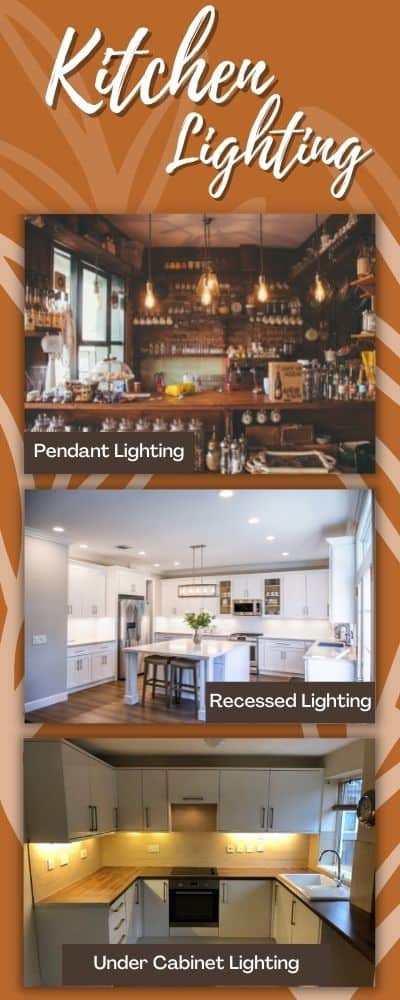

I am thinking of remodeling my kitchen as it is currently dark and not that much fun to cook in. I want a hosting kitchen. Thank you for your tip that you can use accent lighting to create an ambiance more than generating usable light. I am not quite sure how to get the right look, so I think I will look for professionals to help.
Greta
I also have an article about kitchen accent lighting specifically. Agree that you can seek professional help if needed but also dont be afraid to do this yourself.